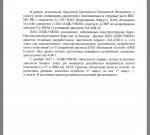Russia To Order Improved Su-30 'Flankers'
by
Vladimir Karnozov
- September 15, 2018, 2:45 AM

Among the 90 or so Su-30SMs delivered to the Russian VKS to date are eight operated by the 'Russian Knights' aerobatic display team. (photo: Vladimir Karnozov)
Russia’s defense ministry intends to procure 36 more Sukhoi Su-30SM two-seat multirole fighters, according to Yuri Slyusar, head of United Aircraft Corporation. A firm order is expected later this year.
The ministry had already provided funds in the 2017 budget for research and development work on the refurbishment of earlier aircraft with higher-thrust engines.
A recently published report by the United Engine Corporation indicates that its Ufa Machinery-Building Production Organization (UMPO) is working on an adaptation for the Su-30SM of the AL-41F-1S engine that powers the Su-35S to attain a higher degree of commonality between the two types. The effort involves the Sukhoi design bureau and Irkut aircraft manufacturing plant. Replacing the current AL-31FP with the AL-41F-1S would result in an extra thrust of four tonnes for the 38-tonne aircraft.
More power promises to boost the Su-30SM’s flight performance and, in combination with a more powerful APU, provide more electric power for the radar. Current production aircraft are equipped with the Bars-R fire control system. It is a further development of the N-011M Bars in the customized Indian Su-30MKI with technology insertions from the later N-035 Irbis that is installed in the Su-35S. While the Bars and Irbis have similarly sized antennas—about 900 mm (35 inches) in diameter—the latter’s emitting power rises from 1.5 kW on average to 5, the peak power from 4.5 to 20, and target illumination from one to two. The Bars-R’s figures fall in between. Refurbished with the AL-41F-1S, an improved Su-30SM may have its radar output brought to levels that match those of the Su-35. Higher radar power would make it possible to employ longer-range missiles. Instead of the RVV-AE medium-range active radar-guided missiles on export aircraft, the Russian Air and Space Force (VKS) employs the more advanced RVV-SD, a further evolution of the baseline R-77.
These and other innovations help boost the Su-30SM’s attractiveness to foreign customers. According to Slyusar, existing orders and commitments enable Irkut’s production line to run to 2022, proceeding at a pace of 12 to 14 units per year. “Export prospects remain in several countries,” remarked the UAC head. Tehran, in particular, has long been asking Moscow for the right to conduct license production, but the Kremlin has been hesitating to strike such a deal before 2020 when UN sanctions on the Islamic Republic expire.
The Su-30SM has already secured 12 orders from Belarus and 23 from Kazakhstan, with the latter declaring an intent to buy 36. India, Algeria, and Malaysia have procured 348 Su-30MKI/MKA/MKM aircraft between them, including kits for assembly at HAL’s Nasik division, a program that is ongoing. Earlier this year, Myanmar signed for six aircraft. This brings the total figure of Su-30MKI/SM exports to more than 400.
At home, the Russian MoD placed the framework contract for the Su-30SM in March 2012, ahead of the first prototype flight in September that year. An initial batch was delivered to the air regiment at the Domna air force base in February 2014. More than a hundred Su-30SMs have been delivered to the VKS and the navy’s air arm. With domestic orders added, the grand total of orders for the Su-30MKI/SM rises to more than 500.
Whereas the Su-30SM is almost impossible to distinguish visually from the Su-30MKI, it differs in having a more advanced avionics and mission equipment, reflecting the advances made during the time between the programs. The first deliverable Su-30MKI flew for the first time in November 2000, while the SM reached that point almost 12 years later. In the customized Indian version the glass cockpit is fitted with Thales 5-by-5-inch MFDs, which were retained in the initial production Su-30SMs. In the future, however, they will be replaced by larger Russian-made units, possibly the 15-inch MFD-35 used in the Su-35S and Su-57.
The Elbit Systems SU967 HUD is replaced by the Thales Avionics SMD55S/VEN-3022 with a wider field of view and sharper, smoother imagery. Work is ongoing to replace it with a Russian system, the candidates being the IKSh-1M as in the Su-35S, or ShKS-5 from the Su-57. The inertial system is the LINS-100RS, a localized Sagem Sigma-95, which is more advanced than the Thales INS/GPS Totem in the Su-30MKI. The RAM-1701 radio altimeter, IFF-1410A IFF, INCOM-1012A communications, and Tarang HADF Mk II radar warning systems that were selected by India for the MKI are replaced by Russian substitutes in the SM. Indian/Israeli EW systems are replaced by the KRET Khibiny series with antennas housed in wingtip pods.
Russia To Order Improved Su-30 'Flankers'






